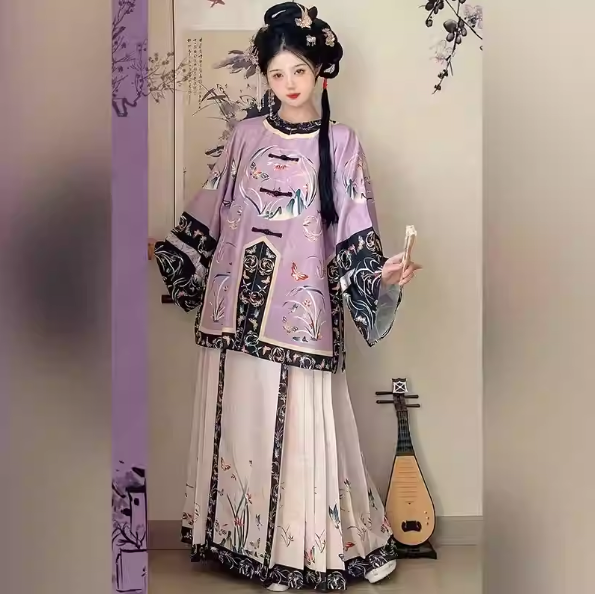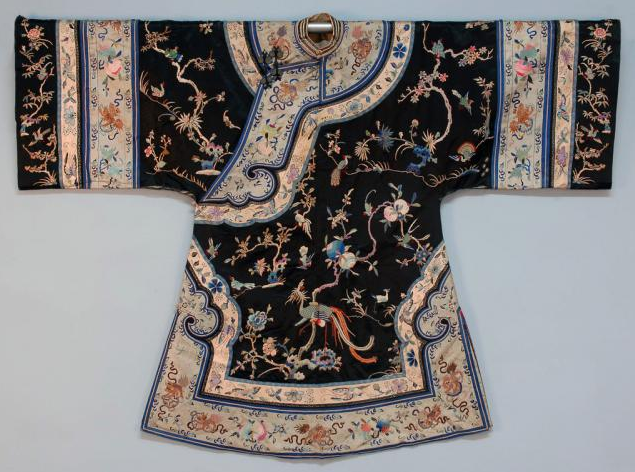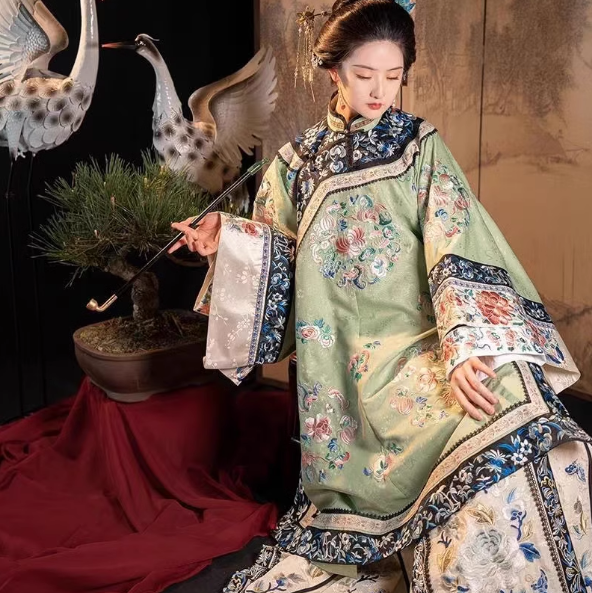Han costumes during the Qing Dynasty included garments such as the Changshan, Qijin, Magua, and more, reflecting cultural diversity and significance.
Overview of Han Costumes in Qing Dynasty
The Qing Dynasty, a pivotal era in Chinese history, witnessed significant transformations in Han costumes. This period, marked by the Manchu rule, introduced unique styles and regulations in clothing, profoundly influencing Han Chinese fashion.
Historical Context and Evolution
During the early Qing Dynasty, the Manchu rulers imposed strict clothing laws, compelling Han Chinese to adopt Manchu attire. However, Han costumes retained distinct features, subtly integrating traditional Han elements with new Qing styles. This era saw the evolution of Hanfu, traditional Han clothing, adapting to political and cultural shifts. The Qing Dynasty’s Han costumes reflected a blend of ethnic diversity, showcasing the fusion of Han and Manchu fashion aesthetics.

Distinctive Characteristics Compared to Previous Eras
Compared to the Ming Dynasty, Qing-era Han costumes exhibited notable differences. The use of vibrant colors and intricate patterns became more pronounced. Garments like the Changshan, a long robe for men, and the Qipao, a form-fitting dress for women, gained popularity. These garments differed from previous styles in their cut, design, and wearability, representing a departure from the more conservative Ming-era attire. The Han costumes in the Qing Dynasty, therefore, stood as symbols of cultural amalgamation, reflecting both resistance and adaptation to the changing times.
For a more detailed exploration of Han costumes during the Qing Dynasty, Wikipedia’s article on Hanfu offers extensive insights into their historical context, evolution, and distinctive characteristics.
Types of Han Clothing
In the Qing Dynasty, Han clothing varied significantly, reflecting social status, occasion, and gender. This period saw a rich diversity in clothing styles, each serving a distinct purpose and adhering to cultural norms.
Formal Attire and Court Dress
Formal attire during the Qing Dynasty showcased elegance and social hierarchy. Court dress, reserved for royalty and high-ranking officials, featured luxurious fabrics like silk and brocade, often adorned with intricate embroidery. Dragon robes, known as ‘Long Pao’, symbolized imperial authority, displaying elaborate designs with dragons, the emblem of imperial power. Officials wore distinctively colored robes, indicating their rank and position. These garments, with their fine materials and elaborate designs, epitomized the opulence of Qing court life.
Everyday Clothing for Common People
Contrastingly, everyday clothing for common people was simpler, prioritizing functionality and comfort. Commoners typically wore tunics and trousers, made from more affordable and durable materials like cotton or linen. Women often wore straight-cut, ankle-length dresses, while men preferred loose robes. Clothing styles varied across regions, reflecting local climates and cultural influences. Despite their simplicity, these garments were not devoid of aesthetic appeal, often featuring subtle patterns and natural colors.
For more comprehensive details on the types of Han clothing during the Qing Dynasty, including their materials and social significance, the Wikipedia page on traditional Chinese clothing provides valuable insights and historical context.
Fabric and Material Use
The Qing Dynasty’s Han costumes utilized a diverse range of fabrics, each chosen for its quality, texture, and suitability for various occasions. This choice of materials played a crucial role in defining the elegance and social standing of the wearer.
Traditional Fabrics Used in Han Costumes
Silk, the most revered fabric, stood as a symbol of luxury and status, often reserved for nobility and the affluent. Cotton, due to its comfort and practicality, was widely popular among commoners. Linen, known for its durability and coolness, was a common choice for summer clothing. Brocade and satin, used for more ornate garments, added a sense of opulence to formal attire. Each fabric, with its unique qualities, contributed significantly to the aesthetics and functionality of Han costumes.
Symbolism and Significance of Colors and Patterns
Colors and patterns in Han costumes carried deep symbolic meanings. Red, symbolizing good fortune and joy, was a popular choice for wedding attire. Blue and black often represented solemnity and modesty. Patterns like dragons, phoenixes, and floral motifs were not mere decorations but conveyed messages of power, beauty, and cultural values. The careful selection of colors and patterns in Han costumes reflected the wearer’s identity, beliefs, and social status.
For a deeper understanding of the fabrics, colors, and patterns used in Han costumes during the Qing Dynasty, and their cultural significance, the Wikipedia page on Chinese clothing offers a wealth of information.
Gender and Age Differences in Attire
The Qing Dynasty’s Han costumes vividly displayed variations based on gender and age, reflecting the cultural norms and values of the era. These differences were evident in the styles, fabrics, and designs of the clothing.
Differences in Men’s and Women’s Han Costumes
Men’s Han costumes typically featured long robes, often paired with a hat as a sign of social status. The Changshan, a type of long robe, was a common choice for men. Women, on the other hand, wore the Qipao or Cheongsam, which evolved into a form-fitting dress by the 20th century, reflecting changes in societal attitudes towards women’s fashion. Men’s attire tended to be more reserved in color and pattern, while women’s clothing embraced brighter colors and more elaborate designs, symbolizing femininity and elegance.
Variations in Clothing for Different Age Groups
Clothing for children and the elderly in the Qing Dynasty also varied distinctly. Children’s clothing often featured bright colors and motifs like animals or flowers, symbolizing good luck and health. The elderly preferred more subdued colors, reflecting wisdom and dignity. Young adults, especially women, wore more intricate and fashionable garments, reflecting their social and marital status.
For further details on the gender and age-related variations in Han costumes during the Qing Dynasty, a visit to the Wikipedia page on traditional Chinese clothing can provide more comprehensive insights into the historical and cultural contexts of these distinctions.
Regional Variations
The Qing Dynasty witnessed significant regional variations in Han costumes, with geography playing a pivotal role in shaping costume styles. These regional differences reflected diverse climates, cultures, and lifestyles across China.

Influence of Geography on Costume Styles
Northern Han Costumes
- Climate Impact: In the colder northern regions, Han costumes were designed for warmth and protection against harsh winters. Thick, layered clothing with padded designs and fur-lined collars were common to combat low temperatures.
- Functional Design: Practicality was emphasized, with garments suited for outdoor activities such as farming and hunting. These designs often featured looser fits for ease of movement.
- Materials: Fabrics like wool and felt were prevalent due to their insulation properties.
Southern Han Costumes
- Warmer Climate: Southern China’s milder climate influenced clothing choices. Lightweight and breathable fabrics were favored to combat heat and humidity.
- Tropical Elements: Some regions in the south incorporated tropical elements, such as bamboo and palm leaves, into hat and accessory designs.
- Color Palette: Bright and vibrant colors were common, reflecting the lush landscapes and vibrant cultures of the southern regions.
Comparison of Northern and Southern Han Costumes
The differences between northern and southern Han costumes were striking:
- Northern Attire: Known for its warmth and functionality, it was often characterized by thicker, darker-colored fabrics and layered designs.
- Southern Attire: Emphasized comfort in hot and humid conditions, featuring lighter fabrics, vibrant colors, and looser fits.
These regional variations showcased the adaptability of Han costumes to the diverse environments and lifestyles of China, reflecting the country’s rich cultural tapestry.
For more in-depth exploration of regional variations in Han costumes during the Qing Dynasty and their geographical influences, you can refer to the Wikipedia page on traditional Chinese clothing.
Cultural and Social Significance
Han costumes in the Qing Dynasty held profound cultural and social importance, reflecting China’s rich heritage and societal hierarchies.

Role of Han Costumes in Social Hierarchies and Rituals
Imperial Court: Hanfu played a pivotal role in the Qing Dynasty’s imperial court. Court officials were required to wear specific robes and headwear based on their ranks, emphasizing hierarchy and authority.
- Rank-Based Attire: Officials’ attire denoted their positions, with distinctive colors and symbols indicating their status.
- Rituals and Ceremonies: Han costumes were worn during important state rituals and ceremonies, reinforcing the emperor’s supreme authority.
Confucian Values: Han costumes were closely tied to Confucian values of respect and filial piety. Filial children often wore clothing that signified their devotion and respect for their parents and ancestors.
- Ancestral Worship: During ancestral worship rituals, families would wear traditional Han clothing to pay respects to their forebears.
- Mourning Attire: Specific Han costumes were worn during mourning periods, reflecting Confucian principles of grief and respect for the deceased.
Preservation and Revival of Han Costumes in Modern Times
Cultural Revival: In recent years, there has been a resurgence of interest in traditional Han clothing. Cultural enthusiasts and designers have sought to revive and preserve the art of making and wearing Hanfu.
- Public Events: Hanfu enthusiasts organize events and gatherings to showcase and celebrate traditional attire.
- Education: Schools and workshops teach the art of creating authentic Han costumes, passing down traditional craftsmanship.
Challenges and Successes: The preservation of Han costumes faces challenges due to changing lifestyles and modern fashion. However, efforts to document, replicate, and educate about traditional clothing have led to successful revival movements.
- Online Communities: Online platforms and social media have played a significant role in connecting Hanfu enthusiasts and promoting the culture.
- Government Support: Some regions in China have recognized the cultural and economic value of preserving Han costumes and have provided support for related initiatives.
For a comprehensive exploration of the cultural and social significance of Han costumes during the Qing Dynasty, along with their role in rituals and modern revival efforts, you can refer to the Wikipedia page on Hanfu for more detailed information and historical context.